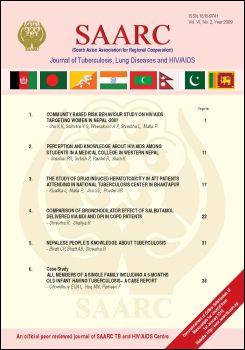Comparison of Bronchodilator Effect of Salbutamol Delivered via MDI and DPI in COPD Patients
DOI:
https://doi.org/10.3126/saarctb.v6i2.3054Keywords:
COPD, Salbutamol, DPI, MDI, SpirometryAbstract
Introduction : Chronic Obstructive Pulmonary Disease (COPD) is one of the leading problems affecting majority of population all over the world which diminishes the quality of life of the individual and create extra burden to the society as well as country. Inhaled bronchodilator therapy is the mainstay of treatment in the management of COPD. Various inhaled [e.g. metered dose inhaler (MDI) /dry powder inhaler (DPI)] formulations are available and are widely used among the COPD patients in Nepal.
Methodology : This is cross sectional prospective study, designed to compare the bronchodilating effect produced when salbutamol is delivered via two devices: MDI (Asthalin® from Cipla) and DPI (Asthalin® rotacap delivered via Rotahaler® from Cipla), in patients with stable COPD. It is proven by previous studies that intervention is necessary to improve the compliance of the patients; all subjects (total n=60; 30 in each group) are counseled and trained to follow correct inhaling technique through particular device. Then their improvements in lung function were measured with reference to the pulmonary function test based on spirometry.
Results : Patients enrolled in each group were not statistically different regarding to age (P=0.318), weight (P=0.324) & BMI (P=0.836). Among the total subjects 87% had smoking history and 2% were still smoking and there was no signifi cant difference in smoking habit between the two groups (p-value 0.544 > 0.05). Similarly 91.6 % of the total had exposure to indoor air pollution which had been the major risk factor for COPD. Most of the patients were on stage II COPD (62%). Salbutamol was found to have no effect on vital statistics of patients. Study showed there was no significant difference in the improvement of forced expiratory volume in one second (FEV1) (p=0.802), FVC (p= 0.693), FEV1 % (p=1) and PEF (p=0.448) between MDI and Rotahaler groups. Major side effect associated with the MDI users is headache (79%) while those among Rotahaler users were muscle cramps (79%). Even though intervention improved the inhaler using technique among the patients in both the groups, it was found even after counseling, DPI seemed to be better understood by the patients in comparison to MDI (p=0.003 & 0.00). In addition DPI was preferred by most of the patients who were familiar with both delivery systems. It was also found to be cheaper than the MDI.
Conclusion : Overall evidence suggests that although both MDI & DPI improve the lung function of COPD patients to similar extent, DPI is cheaper and more preferred and can be easily handled by the patients which can result in reduction of non-compliance.
Keyword : COPD; Salbutamol; DPI; MDI; Spirometry
DOI: 10.3126/saarctb.v6i2.3054
SAARC J. Tuber. Lung Dis. HIV/AIDS 2009 VI (2) 22-30
Downloads
Downloads
How to Cite
Issue
Section
License
Copyright © SAARC Tuberculosis and HIV/AIDS Centre (STAC), all rights reserved, no part of this publication may be reproduced, stored in a retrieval system or transmitted in any form or by any means without prior permission of the STAC.




